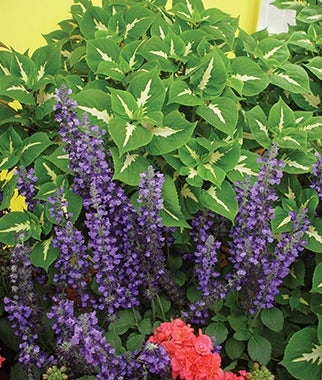We use cookies to give you the best experience on our website. These cookies are completely safe and secure and will never contain any sensitive information. Please read our Privacy Policy. By clicking "Ok" or clicking on any other content, you agree that cookies can be placed.
Texture
In a garden, there are two types of texture: tactile and visual. While it's certainly fun to have touchable plants (lamb's ears comes to mind), the topic of texture is primarily about pattern and form.
Visual textures run the gamut, but generally they can be divided into three basic categories — fine, medium, and coarse or bold (the equivalent, really, of small, medium, and large). Foliage, flowers, bark, and even branch structure all contribute to the textural makeup of a landscape.
The goal is to choreograph a variety of textures to give the garden energy and avoid monotony. Even a mixed container should include something delicate, something of medium texture, and something bold — like alyssum, pansies, and ornamental kale, or asparagus fern, angelonia, and geranium.
By juxtaposing different textures each can be enhanced, rather than competing for attention or getting lost in visual noise. For instance, a cluster of elephant ears has real punch in a bed of salvias, coneflowers, and daylilies; and frothy baby's breath sparkles beside a big-flowered hibiscus. A mass of only elephant's ears or baby's breath, or combining them with similar textures like cannas or coreopsis, lends them much less impact than when they're paired with contrasting textures.
A small landscape should be weighted with fine and medium textures since they can make a space seem larger. Bold plants can make a space seem smaller, so in a pocket garden, too many of them can bring on feelings of claustrophobia! A greater number of big, dramatic plants can be accommodated in a large garden, where they will be in scale and have plenty of "room to breathe." When including finer textured plants in a large border, make sure to plant them in masses so they don't get lost.
But take care not to be overzealous with a particular type of texture. Though fine- and medium-textured plants are what knit a garden together, a border filled with only those can look busy and lack focus, and too many bold plants can be overpowering.
Interestingly the roles of focal point and backdrop can be played equally well by both fine- and bold-textured plants. It's all a matter of good pairings and clever positioning. A variegated hosta pops when planted in front of Japanese painted ferns, and conversely a group of painted ferns sings when backed by lime-green or blue hostas.
It's often assumed that only bold-textured plants bring drama, but delicate plants are equally up to that challenge. What is more dramatic than a mass of thread-leaf bluestar turning brilliant yellow in autumn? Even a small, dainty plant can be made eye-catching, like a mat of baby's tears punctuated by tufts of black mondo grass. Be open to the intrinsic beauty of each plant and how best to show it off.
And don't underestimate the added interest of light and shadow playing across different textures. This can enhance the delicate quality of fine-textured plants such as ornamental grasses, as well as the architecture of bold plants like agaves. When picking planting locations, think about how the sunlight hits the garden during the day and how you can use that to enhance the texture of individual plants.
A few other bold-textured plants are aloe, yucca, Ligularia, caladium, arum, banana, hellebore, and Rodgersia. Medium-textured plants include Heuchera, perennial geranium, snapdragon, petunia, lobelia, and penstemon. For fine-textured plants, look to Jacob's ladder, artemisia, wild bleeding heart, Russian sage, Caryopteris, gaura, and astilbe.
Even an edible garden can have a good balance, using dill, fennel, lavender, asparagus, and thyme for fine texture; sage, peppers, tomatoes, and basil for medium texture; and chard, collards, okra, and lettuce for bold texture.

